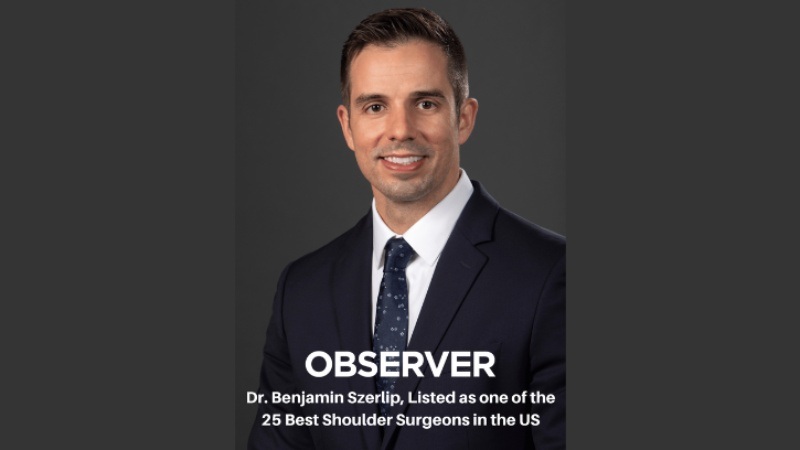
Each year, approximately 7.5 million people in the United States seek medical care for shoulder injuries. These injuries encompass a wide range of issues, from rotator cuff tears, arthritis, and dislocations to fractures and tendonitis, highlighting the significant impact shoulder problems have on the population.
Of these, around 250,000 each year led to the need for shoulder surgery in the United States, including a wide range of procedures including rotator cuff repairs, shoulder replacements, and arthroscopic surgeries.
According to renowned shoulder and sports medicine surgeon Dr. Ben Szerlip, the journey to full recovery following shoulder surgery is a meticulously planned process, each phase designed to restore strength, mobility, and function.
In this guide, Dr. Ben Szerlip brings his expertise to this critical discussion, offering invaluable insights into the phases of shoulder surgery recovery. With a reputation for innovative techniques and personalized care, Dr. Szerlip provides a comprehensive guide to help patients navigate the path from post-operative protection to a triumphant return to their daily activities and sports.
As we explore the phases of recovery from shoulder surgery, please remember that everyone’s situation is unique and that a personalized recovery plan created in concert with your healthcare provider is key to achieving a successful outcome.
Phase I: Post-Op Recovery
Stage 1: Hospital Stay
- Observation: After surgery, you will be monitored in the recovery room until the anesthesia wears off.
- Pain Management: Pain medication will be administered to manage discomfort. A nerve block is often utilized to decrease post-operative pain as well.
- Immobilization: Your shoulder may be in a sling or immobilizer to protect it and support healing.
Stage 2: Discharge Instructions
- Medication: Take prescribed pain medications as directed.
- Wound Care: Keep the surgical site clean and dry. A copy of written instructions will be given on discharge.
- Follow-Up Appointments: Schedule and attend all follow-up appointments to monitor your progress with your surgeon and physical therapy (when recommended).
Phase II: Protection Phase
Stage 1 (Generally lasting between 0-6 weeks)
The initial protection phase spans the first six weeks post-surgery and is critical for safeguarding your shoulder from re-injury. During this stage, your primary objectives are to foster healing, begin to establish a protected range of motion under the guidance of both your orthopedic shoulder surgeon and physical therapist, prevent muscular atrophy, and reduce inflammation and pain. This period involves gentle exercises and minimal movements, closely supervised by your physical therapist to ensure the shoulder is not overstressed.
Stage 2 (Generally weeks 4-8)
In the second stage, your goals shift towards enhancing your range of motion, normalizing joint function (arthrokinematics), improving strength, and continuing to mitigate pain and swelling. This stage involves an increasingly advanced implementation of range of motion exercises and gentle joint mobilization techniques to facilitate better joint mechanics and muscle engagement.
Phase 3: Intermediate Phase (Generally weeks 6-12)
The intermediate phase marks a crucial transition in your rehabilitation journey. During this phase, your focus will be on gradually increasing the intensity of your exercises. This period is designed to restore functional movement patterns and build foundational strength. Emphasis is placed on controlled movements and stability exercises to ensure a safe and effective recovery.
Phase 4: Dynamic Strengthening Phase (Generally Weeks 12-18)
The dynamic strengthening phase is where significant progress is made. To begin this phase, you must have achieved a full, pain-free range of motion, absence of pain or tenderness, and regained at least 70% of your pre-surgery strength. The primary goals during this period are to enhance strength, power, and endurance while improving neuromuscular control. Rehabilitation exercises focus on high-speed, high-energy strength training, diagonal pattern extensions, and eccentric training, which involves lengthening the muscle while it contracts.
Phase 5: Return to Activity Phase
The final phase, the return-to-activity phase, begins once you have a full range of motion without pain or tenderness and receive clearance from your surgeon. The aim is to gradually increase your activity levels and return to unrestricted function. Physical therapy sessions will incorporate resistance band exercises, and dumbbell exercises, and introduce functional activities tailored to your daily life and sports-specific needs.
The Key to a Successful Recovery
Recovery from shoulder surgery is a gradual process that requires time, patience, and adherence to medical guidelines. By following this guide and working closely with your healthcare team, you can maximize your chances of a successful recovery and return to your normal activities.
This guide should provide a comprehensive overview of shoulder surgery recovery, but if you have specific questions about your individual circumstances, it is always best to personalize your recovery plan in concert with your doctor.
Always consult your surgeon or physical therapist with any concerns or questions about your recovery.